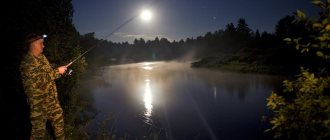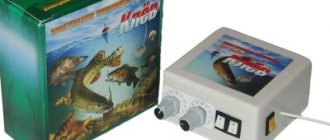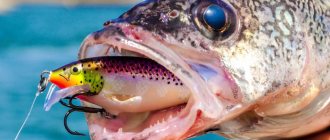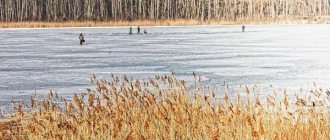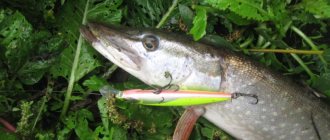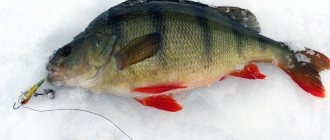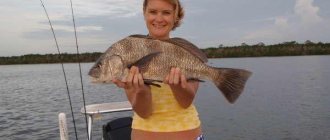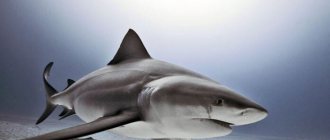Weather conditions have a key impact on the richness of the catch - every experienced fisherman will agree with this. Therefore, you need to go to the reservoir when they are favorable. Moreover, there are several weather factors: pressure, precipitation, wind, air and water temperature, and even geomagnetic conditions. But how do you know when to go, how to determine what weather is right for fishing? Based on the above factors, that’s why today we want to consider at what pressure carp bite, so that you can take into account the state of the mercury column and plan your fishing day based on it.
Use a barometer, visit weather sites, and you will always be warned in advance about weather changes. And, of course, take into account seasonality, because some rules apply when the water is warm, and different rules apply when it’s cold.
Optimal pressure for fishing
In general, many fishermen may have noticed that if the pressure deviates slightly from the norm, there will be a good bite.
Atmospheric pressure is indeed a factor to which the inhabitants of water bodies react very actively. However, using only a small deviation from the 760mm level to determine conditions as optimal for biting is a bit superficial.
There are different theories regarding the effects of atmospheric pressure and the behavior of the inhabitants of the reservoir. It should also be noted that there is no correlation between these phenomena.
Proponents of this opinion point to the ability of fish to change the height of their location in a reservoir and the fullness of their swim bladder, that is, to balance the effect of pressure with the parameters of the body. However, these arguments may also indicate the effect of atmospheric pressure on the behavioral characteristics of fish.
Of course, pressure is not the only factor that can indicate fishing efficiency in a certain period, but there are some studied and repeatedly confirmed relationships that can be used to create more or less accurate predictions regarding fishing efficiency in a given period.
To create a more complete picture, it is useful to take into account other factors, but here we focus on the atmospheric pressure factor.
What signs are used to determine changes in atmospheric conditions?
To determine whether the fish will bite successfully, signs and observations are used.
The following indicators will indicate low blood pressure:
- variability of wind strength and direction, decreased air temperature, increased humidity;
- lack of dew in the morning;
- dense clouds;
- change in water density;
- stability of foam offshore;
- bubbles that remain on the surface of the water for a long time due to the movement of the boat;
- smoke coming from below, fog that does not dissipate during the day;
- the dawn is bright red;
- different direction of clouds;
- sunset into thick clouds;
- appearance of cirrocumulus clouds;
- interference on radio waves;
- flights of swallows and swifts along the bottom;
- strong wind in the evening.
In winter, warming or cloudy weather indicates a decrease in pressure.
An increase in pressure is indicated by the following:
- Clear and cloudless weather.
- Calm wind, lack of precipitation, cloudiness;
- The movement of cumulus clouds in inclement weather with the wind.
- Warm air.
- Clearances in cloudy conditions.
- White, fluffy clouds.
- Air transparency.
- Hazy horizon.
- Heavy dew in the morning.
- Disappearance of the nebula with sunrise.
- Cloudless horizon.
- Temperatures vary throughout the day, cool at night, hot during the day.
- Swallows flying high.
- Wind weakening in the evening hours.
- Smoke coming from above.
Not all of these signs may be suitable for all cases; these are rather generalized indicators. Each area, body of water, and fish has its own characteristics; the fisherman will have to adapt to each specific situation.
Let's celebrate! When planning your next fishing trip, it is advisable to take a closer look at the weather and atmospheric conditions; these factors have a direct impact on successful fishing. You also need to decide what type of fish you would like to “hunt”. Good fishing can be organized at any time of the year, the main thing is to pay close attention to the weather conditions.
Atmosphere pressure
As the name implies, this parameter indicates the pressure of the atmosphere, in particular the pressure on what is located under the atmosphere.
Atmospheric pressure can change over time and depending on the area of measurement, which is usually performed with a barometer, which defines a mercury column pressure of 760 millimeters at zero temperature as normal.
Low atmospheric pressure and fishing
In order to determine low pressure, it is not at all necessary to use a barometer; it is possible to use indirect signs.
In particular, smoke from a fire, which at low pressure dissipates little and spreads low (easy to remember: low pressure - low smoke) and foam, which accumulates near the shore.
In general, low pressure reduces fish activity, and if there is a sharp decrease, then you should not expect a bite. This change results in a significant reduction in fish activity.
However, with low pressure, which decreases smoothly or steadily over a certain period, it is possible to obtain very high results, in particular when catching predators.
The point here is to reduce the activity of non-predatory inhabitants of the water, which descend lower and begin to move less, accordingly, predators try to take advantage of this, that is, they quite actively peck at the bait.
In low pressure conditions, it is effective to try different methods of catching pike and pike perch, burbot and perch, and the opportunity to catch catfish increases.
Increased atmospheric pressure and fishing
High atmospheric pressure causes approximately the opposite picture in water bodies: predators reduce their own activity and fish that consume vegetation become more active.
However, high pressure, as well as changes in this parameter in general, do not affect the behavior of pike perch and even young perches are active in conditions of high pressure.
Otherwise, you should pay attention to fishing on the surface of such species as:
- roach;
- bream;
- silver bream;
- ide;
- chub;
- carp.
They move to the upper layers of water, become more active in search of food and may be interested in a variety of baits. Of course, for each individual variety, the methods that are optimal for them should be used.
Fishing at low and high pressure
Among all weather conditions, it is atm. pressure has the greatest influence on the favorable or negative outcome of fishing. Moreover, pike, perch, catfish, carp and roach react completely differently to lower and higher barometer values.
According to the observations of fishermen, when the pressure drops, predatory fish begin to hunt more actively and it does not matter whether there is wind or not, sunny or cloudy weather, regardless of the time of day and phase of the moon.
Especially if it has dropped, after the weather had been stable with high atmospheric pressure for several days, the predators begin to really eat.
There is a hypothesis that they are trying to get enough before the weather changes, fearing that it will become much more difficult to do so later.
Atmospheric pressure drops with the arrival of a cyclone and rises with an anticyclone. Predatory fish begin to bite poorly several hours before the arrival of the anticyclone.
At high pressure, the predatory fish becomes passive, but during this period the whitefish willingly bites. Without fear of predators, the white fish begins to look for food. White fish activity is observed from the moment the barometer needle begins to creep up and continues throughout the entire stabilization time.
Since with the arrival of the anticyclone, windy and clear days are established, therefore, it is in such weather that it is better to catch white fish. During this period, whitefish bite throughout the daylight hours.
The worst bite is observed with sharp jumps on the barometer, both down and up. At these moments, the fish seems to be in limbo, does not go to any of the baits and becomes active, or, conversely, stops eating only when stable pressure is established.
Consequently, it bites best when there are no sharp jumps that cause equally sudden changes in the weather. Remember, if the weather does not change for 3 days, favorable conditions for fishing are created. It is believed that if the temperature and pressure of the atmosphere do not change for 7 days, the fish bite will be ideal.
Optimal atmospheric pressure for fishing
To say what is the best pressure for fishing, you must first decide what you are going to fish. If the goal is to catch a predatory fish, then you need to wait until the barometer starts to fall. See the table for the best values (indicated in mm of mercury, abbreviated as Hg).
| Pike | 758-764 mmHg (there should be no strong jumps) |
| Perch, Pike-perch | 758-762 mmHg (may fall, rise or remain unchanged, but the values should be within the normal range) |
| Bream, bream | 755-760 mmHg (good if the values do not change or increase slightly) |
| Carp, crucian carp, tench | 755-765 mm Hg (comfortable pressure has a wide range, which is why carp fish bite more often than other species) |
| Catfish, burbot | 750-770 mm Hg (no correlation with a suitable pressure value for a good bite) |
| Grayling, Trout | 758-762 mm Hg (pressure does not change, a slight decrease is acceptable) |
The chances of returning with a rich catch are much higher. If you want to catch whitefish, you will have to wait for the arrival of the anticyclone, and with it, sunny days. It is at this time that she takes the bait more actively.
Optimal atmospheric pressure for fishing
As is clear from the previously cited facts, different pressures are optimal for different types of fish. Predators are more active at gradually reduced pressure, non-predators are more active at high pressure. Increasing pressure affects the density of water and non-predators become more comfortable in the upper layers.
Phases of atmospheric pressure changes
These phases should be considered as the least effective in terms of biting. If sudden changes are observed, underwater inhabitants may completely stop their activity until the pressure stabilizes.
Signs of pressure changes
It is actually quite easy to detect pressure changes. For example, in the summer, any changes in the weather indicate changes in pressure, in particular, if such changes are very significant, for example, warm weather changed to rain.
In winter, pressure changes are less significant, although they have a greater impact on fish activity.
At what pressure does carp bite?
Weather conditions have a key impact on the richness of the catch - every experienced fisherman will agree with this. Therefore, you need to go to the reservoir when they are favorable. Moreover, there are several weather factors: pressure, precipitation, wind, air and water temperature, and even geomagnetic conditions. But how do you know when to go, how to determine what weather is right for fishing? Based on the above factors, that’s why today we want to consider at what pressure carp bite, so that you can take into account the state of the mercury column and plan your fishing day based on it.
Use a barometer, visit weather sites, and you will always be warned in advance about weather changes. And, of course, take into account seasonality, because some rules apply when the water is warm, and different rules apply when it’s cold.
How do some types of fish behave when pressure changes?
During the day, pressure can certainly change and this factor is not a reason for a decrease in fishing efficiency if we take into account the impact of these changes on the bite.
It is most convenient and expedient to focus not on changes in pressure as such, but to observe changes in direction and, even more so, wind forces, which are associated with changes in atmospheric pressure.
The most famous examples:
- north or north-west wind - crucian carp is caught;
- south wind - activates heat-loving varieties, that is, carp and carp.
Some varieties respond to pressure less than other parameters. For example, pike are more sensitive to temperature than to pressure.
The influence of air temperature on carp biting
There is a simple relationship: the hotter it is outside, the higher the air temperature, the warmer the water.
And carp, like any fish, is a cold-blooded creature. Consequently, he “warms up” with water and the warmer it is, the more active our hero behaves. Hence the conclusion: the higher the air temperature, the better the carp bite, and vice versa. True, if it’s hot outside and the water is really hot, the fish will not be active - it will only start looking for food at night or in the evening. So on very hot days we don’t recommend waiting for a bite - it’s practically useless.
Reasons for changes in fish behavior related to atmospheric pressure
In general, this topic requires detailed study if you want to thoroughly study various physiological processes and their dependence on atmospheric pressure.
Various theories regarding the effects of pressure on fish behavior have previously been pointed out. Here the clearest and most accessible explanation should be given, which takes into account fish as living beings that, like many others, react to pressure.
People with low blood pressure, as a rule, become lethargic and apathetic, something similar is observed in fish.
Likewise, with high pressure, the blood vessels become smaller and a greater appetite appears, which in turn makes the inhabitants of the water more interested in searching for food. Although the characteristics of each individual variety should be taken into account.
The influence of atmospheric pressure on biting in winter
In winter, the illumination factor is less important for reservoirs, since the illumination is evenly smoothed out by a layer of snow. Fluctuations in temperature and waves (currents) of water equally become less fluctuating.
Thus, it is atmospheric pressure that becomes a more significant factor that determines the behavioral characteristics of the inhabitants of reservoirs.
There is a certain dependence between the quantitative characteristics of biting in winter and atmospheric pressure parameters.
In general, the most optimal period is when there are no significant pressure fluctuations for at least a couple of days; in such conditions, regardless of the variety, the bite is greatest.
Accordingly, the smallest bite is observed during fluctuations that last for a certain number of days.
The difference between the winter bite at high (that is, more than 760 mm) or low (that is, less than 744 mm) is not observed as such.
Although high pressure is more preferable in terms of further fluctuations, since, as a rule, it decreases smoothly (more favorable conditions) in contrast to low pressure, which can increase abruptly and fluctuate, that is, create not the most optimal fishing conditions.
The influence of water level and transparency on carp biting
The cloudier the water, the bolder the fish, because it is more difficult to notice from afar, and vice versa. The clearer the water, the lower the activity of the carp. It is clear why: the fish is cautious, swims deeper, hides longer in shelters so that the predator does not notice it.
Water clarity is impaired by:
- heavy precipitation (usually rain)
- discharges of industrial liquids
- decomposition of algae (“bloom”)
The water level is affected by:
- melted snow and glaciers, heavy rains - “work” to increase;
- droughts - on the contrary, lower the level;
- human activity - water intake for the needs of enterprises, raising the level at hydroelectric power stations, lowering the sluices, and so on.
Now about the water level: if it rises, the activity and, accordingly, the carp biting also increases. This is explained by the fact that with a spill more food appears and is washed into the water area. Conversely, when the water level drops, carp activity decreases. The fish begins to look for deeper places, so it becomes more difficult to catch them.
What atmospheric pressure is best for fishing in summer?
In summer, the best conditions for non-predatory fish are an anticyclone and stable sunny weather. For predatory fish, stable low pressure is optimal. Pressure drops are not optimal for virtually all grades.
What pressure is best for crucian carp fishing?
Crucian carp is an unpretentious fish in many respects, but fishing for crucian carp is a very difficult process in terms of choosing the optimal period, fishing area and other conditions. However, atmospheric pressure is not decisive here and you should just avoid fishing in phases of sudden changes.
Tips about pressure and fishing
To summarize the above, it is useful to provide some tips that can be used in practice and help anglers improve their fishing performance:
- A sign of a good bite is a slight deviation from normal pressure, that is, slightly less or more than 760 mm on the barometer.
- In winter, pressure is one of the main factors in the behavioral characteristics of fish, acquiring greater importance compared to light and temperature, unlike other periods of the year.
- It is possible to navigate according to the barometer weather data: a bad bite if the barometer shows “good weather” or “rain”, a good bite if the values are between “rain” and “clear weather”.
These tips, combined with the information provided, will help you better navigate in choosing the optimal pressure for fishing. Now the barometer can significantly help when choosing a fishing period, as well as indirect signs of pressure changes.
Optimal conditions for carp fishing: weather, wind and pressure
Despite the fact that in the fishing world there are conventional divisions into feeders or carp anglers, amateurs or athletes, etc. But carp was, is and will be for centuries the most desirable fish for any person who is not indifferent to fishing. In truth, fighting qualities, serious weight and sometimes simply enormous size attract the mind of any fisherman.
In our previous articles, we wrote about a variety of methods for catching carp, about bait, about finding a suitable place to start fishing, but we have not yet considered the question: how does atmospheric pressure affect fish? What weather factors (depending on the season) have a significant impact on the feeding behavior of carp?
A more or less knowledgeable person will immediately agree that the bite of this fish is a very unpredictable thing, and very often defies the logic of things. Unfortunately, we humans (unlike fish) do not always fully understand how to determine with maximum accuracy the most important nuances that affect the appetite of carp.
Let's say we have already thoroughly figured out how to properly scout places for carp fishing, how and what to feed it with, and we even know that there is a lot of this fish in a particular body of water. But that's not all! Since there are other equally important “external” factors that seriously affect the intensity of fish biting.
“External” factors influencing carp biting
So what are these factors? For several decades now, experienced world-famous carp anglers have been asking us to take into account: the time of year (divided into 4 seasons, and at least 2 more sub-seasons). Current weather conditions (against the background of a long-term forecast), water temperature, atmospheric pressure, geomagnetic situation and moon phases. And also not just the wind, but its clear direction, strength and temperature.
It’s clear that for an ordinary amateur fisherman all this data is not needed (except perhaps some of it), and for beginners this whole thing is a “dark forest”. And many people plan fishing not for that period - when everything will be “super”, but when the days off from work come. Naturally, we would all like to live near the best pond and go to the fishing site on the most favorable days. But life has other plans, so you have to take up your favorite hobby in your free time. So what should we do?
Regional carp fishing forums – tip #1
The ideal option is to definitely find a fishing forum, specifically from your region. Not a single website or even magazines can help you accurately determine and predict the behavior of carp, as the carp fishing forum will do (including ours (!)). Here, many people describe not only their catches, but also many other nuances. Having carefully “monitored” them, you can already understand that on some days it is worth fishing on a nearby lake, and on others, on the contrary, it is better not to “make unnecessary movements”. Or, nevertheless, do it in order to prove to others your superiority.
Having a clear idea of today’s or yesterday’s state of affairs (in terms of biting in your area). And also, having carefully studied the information about what happened a couple of years ago, and knowing the weather forecast for the week ahead, you can already plan something successfully. It’s just very important not to forget to describe your successes in detail later. By leaving valuable comments / reviews / feedback / reports on our forum (or others), you are making your contribution to a very useful common cause. We should always try to help each other, and “karma” will reward us a hundredfold.
The most important wealth of an angler is personal experience!
Of course, valuable advice from scientific ichthyologists or carp fishing experts is very necessary for us, but the most valuable information will be the one that is based on purely personal experience. Correctly recognizing the slightest changes in the behavior of carp, knowing its habits and taste preferences in a specific body of water is only possible when you already have your own “baggage” of knowledge. Well analyzed and sorted out in the mind “on the shelves”.
You can read a lot of articles on different sites about trouble-free carp fishing, but (!) this will not be a panacea, that is, “golden” advice for any situation. Since each region of the country has its own specific nuances that affect the behavior of fish (pressure, wind, weather conditions, terrain, etc.). And even between lakes located nearby, there can also be differences. Therefore, your own understanding of all these processes, based on analysis and many years of observation, is what will give an excellent result!
Next, we bring to your attention the main points (basics), based on which you can learn to make your own forecasts for fishing in the future.
Best atmospheric pressure for carp fishing
Let's start with the fact that any changes in atmospheric pressure (as well as its established values) have a significant impact on the behavior of fish (especially on its appetite). Nowadays, you can observe it not only using a home barometer, but also according to data (published daily) on the pages of many meteorological sites.
Although, we cannot find a better, and most importantly, reliable assistant than a home wall barometer (mentioned above). After all, as you know, most forecasts on the Internet are formed “from a flashlight”. So, back to the topic:
- if the pressure drops, then you should expect precipitation, wind or cloudiness,
- if it grows again, the weather will soon be better.
At what pressure does carp bite in summer?
During periods of persistent hot/hot weather, virtually any fish will not be active. That is why, at such periods of time, carps will bite in the morning, late evening or at night. That is, when it's cool. So, using this situation as an example, we can safely say that a decrease in atmospheric pressure “signals” to us that a cold cyclone is approaching, which means that the bite will also change. Naturally, for the better.
According to scientists - ichthyologists, for the carp family the optimal “summer” pressure (i.e., conducive to an active search for food) is either short-term - low, or gradually falling. Combined with clouds and a light breeze. However, it is worth considering that during such periods there may be sharp (!) jumps (usually accompanied by thunderstorms). This means that even within a day, our chances of getting a bite can change several times: from the highest to zero.
It is definitely worth noting two more important points. The first nuance is that everything described above relates more to the abnormal weather phenomena that have been occurring so often lately. For example, record high temperatures lasting 2-3 weeks in July. The second is that in case of established “bad” weather (with long-term low pressure) in the middle of summer (and this happens once every 3-4 years), the carp will also lose activity (almost to zero). Therefore, the best time to go fishing will be, on the contrary, when it (!) increases.
Pressure for carp fishing in other seasons
In spring, autumn and winter, and in some regions even early or late summer, atmospheric pressure also affects carp (especially their bite). It is widely known that the metabolism (metabolism) of virtually any species of fish directly depends on water temperature. In some varieties the range of its changes is higher, in others it is lower. The optimal temperature for normal feeding behavior of the carp family is above 10 degrees Celsius.
In stable cold and windless weather (and, as a rule, high pressure), the temperature will be constantly low. It’s clear that this period of time will not be the most successful for great fishing. But, with its decrease, and therefore future warming and an increase in humidity levels, the carp will definitely (!) diligently look for food in the warmed areas of the reservoir. Trying to gain as much fat as possible.
The influence of wind on the feeding behavior of carp
One of the main factors that also seriously influences the bite is the wind. And the key points here are not only its strength and direction (which we will discuss in detail later in this article), but also many other nuances. Namely: the wind is capable of cooling or, conversely, heating the temperature layers of water. Enrich it with useful oxygen, raise the level of a reservoir/pond or lake, move food and “garbage” at the bottom, etc.
As a rule, experienced carp anglers know from “A” to “Z” all the features of nearby bodies of water, including the direction of the wind. With one of them (for example, the northeast), the bite literally “cuts off”; with the other (for example, the southwest), the situation changes radically for the better. It is only important that the wind force be insignificant (up to 10 meters per second), since with stormy or gusty air currents (up to 20 meters per second), it is clear that the carp will no longer be willing to feed.
The next important point is the wind temperature, which very often depends on its direction. Therefore, a cool northern breeze on hot summer days significantly increases our chances of catching fish. Equally, southern warm air currents in the cold seasons of the year (warming up the water) contribute to the manifestation of carp activity. In addition, it is worth considering that prolonged winds (“blowing” for several days in a row) are capable of “moving” the main part of the food supply at the bottom of the reservoir (except for the deepest holes).
Carp that live in ponds or lakes (with “stagnant water”) generally have the characteristic feature of constantly moving in the direction of the wind. And they do this for several reasons:
- Firstly, less energy is wasted this way (moving without resistance to oncoming underwater currents);
- Secondly, of course, they “go” for food, which the wind “rolls” along the bottom of the reservoir to other places;
- Thirdly, for example, the southern directions of air masses (especially in cold seasons) are able to warm up the water well on the opposite part of the reservoir. It is logical that the fish will go there. Where it is not only warm, but also something to “breathe”. And also a lot of edible elements have accumulated, brought not only by the underwater current, but also by the surface current (i.e., waves).
Experienced carp anglers, even within a day, can change several fishing spots at once, depending on the direction/strength of the wind and the position of the sun (or more precisely, the direction of the sun's rays).
Ideal weather for carp fishing
The best weather for carp fishing is considered to be stable, good weather with normal atmospheric pressure for your region. By the way, it is calculated depending on the height of your area above ocean level. Sudden weather changes make carp very nervous. During such periods, the bite stops completely. Although, during abnormal summer heat (which we wrote about above), the carp family, on the contrary, becomes active. But, in general, the most suitable weather for carp fishing depends on the season (i.e. time of year).
For example, for the summer months one can name such signs of “catchable” weather as a light moderate breeze, cloudiness (both variable and complete), perhaps even “mushroom” rains or short thunderstorms. An interesting fact is that carp begin to bite worse (or better) even before the weather changes in reality: a day or even several hours in advance. That is why it is very important to study forecasts for several days in advance in order to assess all the chances of success. And maybe don’t waste time, but put off fishing for another time.
In conclusion
In summer, carp have a good appetite both day and night (moreover, sometimes night bites, given elevated temperatures, are even better than daytime bites). In cold seasons, the best option would be fishing during daylight hours. Some carp anglers even take into account the phases of the moon, since it is believed that when it “grows”, things will go better. However, the most important factors, sometimes immediately influencing the bite, are: pressure, wind and weather changes. And, of course, our valuable experience! Thanks to which, you can plan a good fishing trip or find a solution on how to get out of even the most difficult situations “without losses.”
carpfishing.ru
